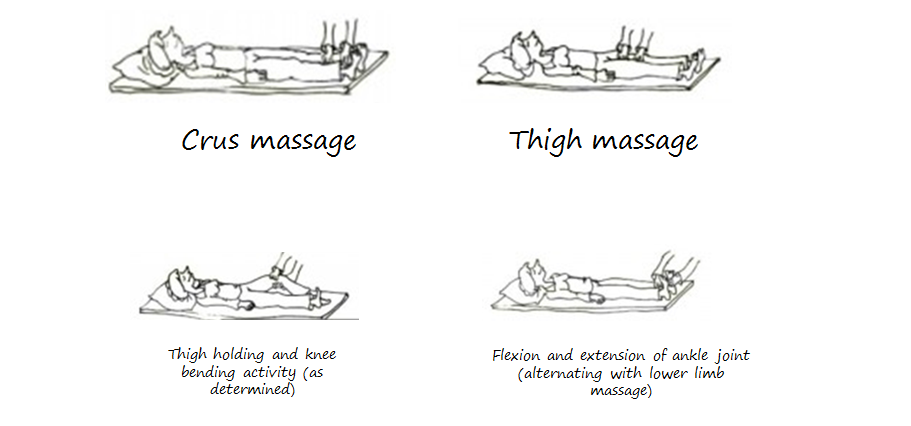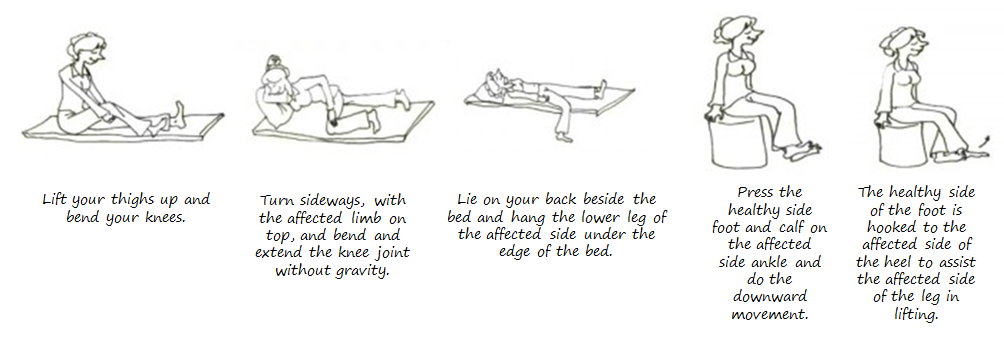1. Observation of incision drainage tube: due to the use of tourniquets during the operation of knee arthroplasty, vascular reactive dilation and bleeding of vascular stump at the site of intra-articular tissue resection are often caused after surgery. Blood infiltration of incision dressing and color, quality and quantity of drainage should be closely observed. The catheter was extubated 24-48 hours after the postoperative drainage, when the drainage volume was less than 20ml/d. To keep the drainage tube in the process of drainage unobstructed, prevent distortion, folding and congestion, once every 30 minutes extrusion, such as found fast drainage tube flow velocity is higher than 100 ml/h, shall notify competent doctor, to keep the incision dressing clean and dry, once the pollution changes in time, the orders timely and correct use of antibiotics gauze, preventing incision infection.
2. Postoperative position: After operation, patients should take off the pillow and lie supine for 6 hours. After 6 hours, patients should take supine position. The soft pillow behind the knee of affected limb should be raised to maintain neutral position, so as to avoid excessive compression of the calf gastrointestinal muscle and the common nerve, resulting in thrombosis of the calf gastrointestinal venous plexus and injury of the common nerve.
3. Observation of blood supply of affected limbs: Pay close attention to the sensation of affected limbs, skin temperature of affected limbs, skin color and pulsation of dorsal pedal artery, and deal with abnormal cases in time.
Postoperative Complications
1. Postoperative infection
Including wound and intra-articular infection, urinary tract infection, pulmonary infection and so on, can lead to fever. Therefore, we should closely observe the changes of patient's body temperature and blood liquefaction test value, keep the wound dressing dry, and replace it in time after contamination. Wound infection mostly occurs in 1-3 weeks after operation. The patient complains that the pain is aggravated or relieved and then aggravated, the body temperature is increased, the pulse is fast, the leucocyte is increased, and there is local redness, swelling, fever and pain.
Prevention: 1. Nursing of the urinary catheter: It is better to keep the urinary catheter for 24 hours and keep it unobstructed. Perineal care should be done daily to encourage patients to drink more water. 2. In order to prevent pulmonary infection, teach patients to breathe deeply and cough effectively, cough up phlegm as much as possible, kowtow on the back of patients in the morning and evening nursing every day, and inhale atomized whenever necessary. 3. Pressure sore prevention: due to poor blood circulation of the elderly, long-term bed rest after surgery, less activity, low body reaction, pressure sore is easy to occur, should increase nutrition, keep patients' sheets dry and clear, avoid body and bed contact friction and shear force, reduce the pressure on tissues. When lying flat, the patient's toes are pointed upward, and sponge pads can be padded under his feet to prevent pressure sores on his heels. Regular help patients turn over, can reduce the formation of back pressure sores.
2. Hematoma
Hematoma can cause bone healing disorders and increase the chance of infection, mostly in elderly patients and patients with more joint activity within 48-72 hours after operation.
Nursing of hematoma: Before operation, doctors should explain to patients that non-steroidal anti-inflammatory drugs, hormones and other drugs should be discontinued to reduce bleeding during and after operation. The drainage tube was observed. Once the hematoma appears and continues to increase, the doctor should be informed in time. Anti-inflammatory treatment was given according to doctor's advice.
3. Hemorrhage
The amount of blood in total knee arthroplasty is about 400 ml-2000 ml. Most of the patients can safely survive the perioperative period by using autologous blood and drainage blood reinfusion technology, without transfusion of allogeneic blood.
Nursing of hemorrhage
1) Before operation, we should carefully inquire about the tendency of family hemorrhage, the history of previous hemorrhagic diseases and hepatitis, and the recent use of salicylic acid drugs, hormones and anticoagulants. 2) Autologous blood was reserved before operation. 3) Autologous blood drainage should be transfused in time within 6 hours after operation. 4) Closely observe the changes of vital signs and urine volume. 5) Closely observe the drainage flow, the operation should be within 200-400 ml within 1-2 hours, if the amount of continuous bleeding exceeds 1000 within 10-12 hours after operation, it should be paid attention to and notified the doctor immediately.
4. Pain
The treatment of pain after knee arthroplasty is more demanding than that after hip arthroplasty. Good pain management not only makes patients feel comfortable, but also helps the rehabilitation of limb function after operation. The advantages of intramuscular or subcutaneous injection of analgesics are low cost and easy to use, but there are many side effects, such as vomiting, respiratory depression, vertigo, blood pressure drop and so on. The patients with knee arthroplasty are generally older and should be carefully used. PCA, the most common analgesic pump, is intravenous analgesic drugs, the pump is controlled by patients, patients can control the dosage of drugs according to their own pain situation. PCA has the advantages of self-control, reducing patients' anxiety, increasing sense of security, relatively rare side effects, occasional nausea, vomiting, urinary retention. After symptoms occur, PCA is temporarily shut down and can be reused after relief.
5. Lower extremity venous thrombosis
Deep vein thrombosis (DVT) is the most common postoperative complication, with an incidence of 40% to 70%, and the incidence of pulmonary embolism secondary to DVT is 4.6% to 19.7%. If no active prevention and treatment measures are taken, 0.5% to 2% of patients with pulmonary embolism are at risk of death.
Clinical manifestation and observation
1) swelling of lower limbs and filling of superficial veins; 2) changes in skin color and temperature; 3) tenderness, obvious tenderness along femoral vein
Prevention
1) postoperative anticoagulant prophylaxis: LMWH, Dalteparin; 2) the application of intravenous pump can reduce the incidence of DVT after operation from 45% to 50% to 10% to 20%. It is not suitable to use both lower limbs at the same time, especially for the elderly with cardiac insufficiency. 3) encourage the patient to manic joint and early movement of knee joint; 4) wear elastic socks with different pressure order; 5) elevation of affected limb.
Functional exercise
1-3 days after surgery
Continuous passive activity, massage every 2 hours for 10 minutes. In addition to restoring knee function, there are traction contracture tissues to avoid adhesion, promote blood circulation of lower limbs, and prevent deep venous thrombosis and embolism. (Completed by escorts under the guidance of medical staff)

Active training, muscle length contraction exercises, every 1 hour 10, each movement for 10 seconds.

4-7 days after operation, 5-10 times every 2 hours.

8-14 days after operation, 5-7 seconds, 3-4 groups of exercises per day, 20 times per group


15-28 days after operation

Prognosis
Outpatient department takes film to check, after having no abnormality, continue afore-mentioned rehabilitation exercise, till restore normal or close to normal daily life. This stage can start to engage in some of the more intense sports such as swimming. After three months you should return to full normal life.
Walking
When standing upright, you should feel comfortable and balanced. Then you should move the walking device or crutches forward a little distance. The knee joint of the operative side should move straight and forward. First, you should make the heel to the ground, move the body forward, then flatten the foot, and finally leave the ground by the toe.
Walking frequency, walking distance and walking speed should be uniform. As muscle strength and endurance increase, the walking time can be gradually extended. But should not be tired, pay attention to the protection of the knee.
Up and down the stairs
Going up and down stairs requires strength and coordination, which is the best exercise to increase physical strength and endurance. You need help at first, until you regain enough strength and balance and coordination. Step by step, not in haste.
Exercise at home
After returning home, the patient continued to do knee bending, stretching and muscle rehabilitation exercises. After general operation, the affected limbs should not be fully loaded within six weeks, and crutches should not be used after three months. After 6 months can swim, play golf and other gentle sports, but avoid jumping, squat, running, tennis, basketball and other strenuous sports.






